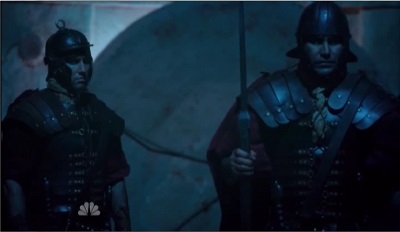| The series “AD – The Bible Continues” presents a strong case for the resurrection of Jesus. |
In part 1, Jesus’ death and the empty Tomb, the uniqueness of Christianity was examined through a consideration of the following questions:
Why believe in Christianity?
What makes Christianity different from any other religion?
Why not believe in other religions?
What makes Jesus different from the founder of other religions?
How do you know Christianity is true?
Why should I believe in Jesus?
The answer to all those questions is resurrection of Jesus Christ from the dead – it is the answer to each question, and what makes Christianity unique. Furthermore, Christianity is the only religion which provides hope for us mortal men and women through a savior who has demonstrated mastery over death by himself rising from the dead. And that savior offers the same resurrection to all who believe in him.
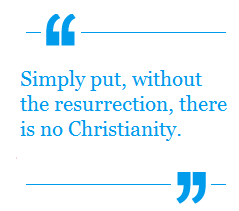
That claim – resurrection from the dead – is so startling, so bold, so beyond common experience that some people refuse to even consider it as a possibility. Such doubt has been expressed by the well known liberal scholar, the late Rudolph Bultmann who in his disbelief writes,
“An historical fact which involves a resurrection from the dead is utterly inconceivable” [1]
Though he doubts the reality, Bultmann demonstrates instead of taking the claim lightly, he understands the gravitas of the claim, as well as the fantastical, foreign-to-this-world nature of the concept of a physical resurrection from the dead. What we’re discussing is no mere medical resuscitation of a person dead for a few seconds or minutes. We’re talking about a person who was dead, and verified dead by thrusting a spear through his lung and heart[2], was wrapped in the burial clothes of the day, then buried.
Bultmann correctly points out the impossibility of a resurrection for a mere human. But Jesus is no mere human, he is the Son of God, fully God and fully human. That is why “it was impossible for death to keep its hold on him.” (Acts 2.24) The Jewish leaders recognize another aspect of the resurrection – the threat to their authority. Jesus claims to have “all authority in heaven and in earth” (Matt 28.18), and that claim was verified with power by his resurrection from the dead (Rom 1.4) in fulfillment of scripture regarding the messiah.[3]
Thus upon the resurrection, hang all of Jesus’ claims, and indeed all of Christianity. Simply put, without the resurrection, there is no Christianity. Not only do the Jewish leaders of Jesus’ day recognize this, but every skeptic and anti-Christian denier who have tried to debunk the Christianity and prove it false recognizes it. But like a child who plays in the mud, and walks in the house covered it in, but denies it; their attempts to disprove the resurrection are equally transparent, equally easy to refute and equally wrong. Following are the main attempts to deny the resurrection along with clips from AD – the Bible Continues that illustrate well the truths that refute the various denials.
Failed Attempts to Explain Why The Resurrection Isn’t True – (Part 2)
1. Jewish Conspiracy Theory
This is a very early attempt by the Jewish leaders of Jesus’ day to provide a counter explanation to the proclamation of the apostles. Their explanation: the disciples stole the body of Jesus while the guards were sleeping. The gospel writer Matthew records that the chief priests paid the guards “a large sum of money” to spread this lie. (Matt 28.12-15) (Click the picture to see the AD depiction.)
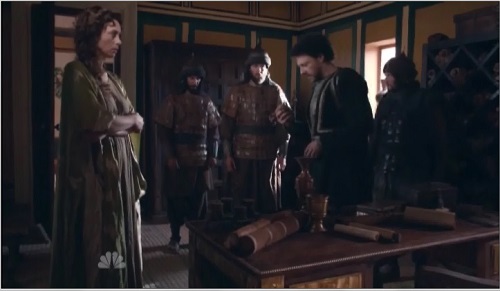
The chief priest pays the guards to say the disciples stole the body why they slept.
Click to view (MP4 format) (wmv [IE])
Please note two things:
First, as apologist William Lane Craig points out,
“Finally the earliest Jewish response to the proclamation of Jesus’ resurrection presupposes the empty tomb.“[4] (emphasis his).
The fact that they are making up a story about what happened to the body confirms that the tomb was empty.
Second, note the options the Jewish leaders did not have:
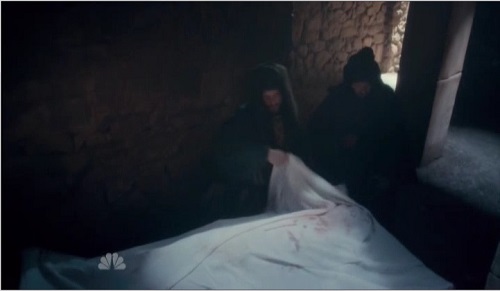
The high priest considers, and rejects the option to parade an imposter corpse as Jesus.
Warning: graphic wounds depicted. (mobile/tablet format)
a) As AD points out (above), they could not have supplied a dead imposter to claim that Jesus was still dead. Because with Jesus’ apostles, and many other disciples and people who had seen him still alive and present, as AD points out, the conspirators would never would have gotten away with it because it would have been readily apparent to anyone who knew Jesus the imposter was a fake, and the temple leaders would have shown to be lying deceivers.
b) They did not have the option to claim any of the empty tomb explanations in the previous post. They couldn’t say the disciples went to the wrong tomb – the easy solution to that is go to the correct tomb and show Jesus is still dead. They could not say Joseph had relocated the body – Joseph would have corrected that; additionally he did not have time to do so with guards there, and without being seen by the women who arrived early Sunday morning. Thus the tomb remains empty and they are left with the problem of explaining the empty tomb, or producing the body of Jesus; neither of which they could do.
Thus given the fact of the empty tomb, the Jewish Leaders who refused to acknowledge the resurrection took the only course of action they could: deny the resurrection, lie about what happened, and pay the guards to become accomplices in the lie.
2. The Hallucination Theory
3. The Mistaken Identity theory
Theories two and three – the hallucination theory and the mistaken identity theory – are both feeble attempts to explain away the most powerful evidence of all: The appearance of Jesus of Nazareth, alive, in the same physical body, after he had been crucified, dead and buried. The hallucination theory posits that the disciples only hallucinated seeing Jesus alive after his death; the mistaken identity theory – that they mistook someone else for Jesus. The answer to both is the same: The resurrection appearances summarily dismisses both. Theologian Norman L. Geisler explains well why the disciples were not mistaken:
“the resurrection appearances cannot be cases of mistaken identity. There were too many people (over five hundred) who saw Jesus, on too many occasions (twelve), over too long a time (about forty), with too much physical evidence of His identity and reality. They saw Him, heard Him, touched Him, saw His crucifixion wounds, observed the empty tomb and grave
clothes, and ate with Him on at least four occasions”[5]
Notice the same reasoning applies to hallucinations – with even more force since it is unheard of for multiple different people to experience the exact same hallucination, at multiple different times, involving multiple senses. That’s simply not how hallucinations work.
Following are some of the appearances of Jesus mentioned above, as depicted in AD the Bible Continues. (Notice in the appearance with Thomas present, they include the reference to the above defense – the impossibility of all the disciples being mistaken in the same way at the same time.)

Jesus appears to Mary Magdalene (mobile/tablet format)
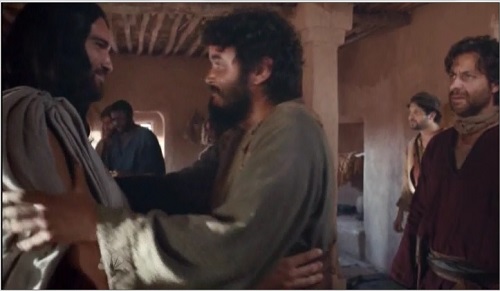
Jesus appears to the disciples, Thomas is absent. (mobile/tablet format)
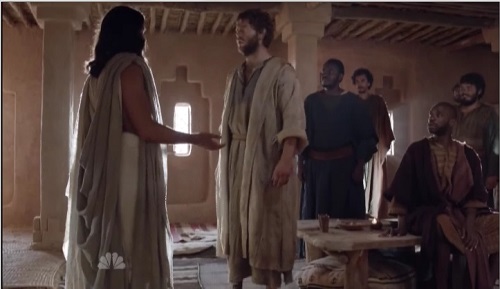
Jesus appears to the disciples, Thomas is present (mobile/tablet format)
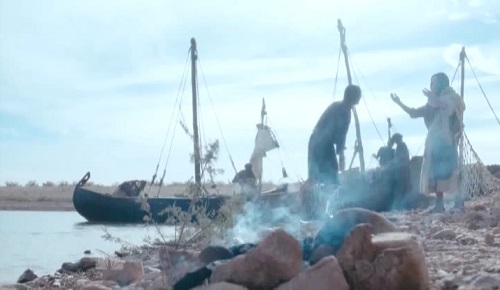
Jesus appears by the Sea of Galilee where they have a miraculous catch of fish.
(mobile/tablet format)
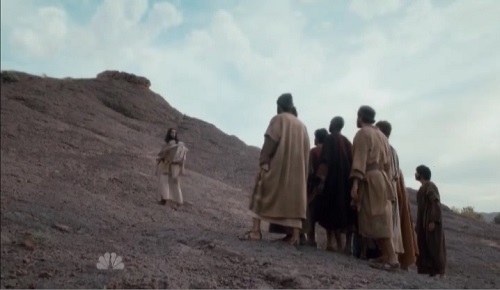
Jesus appears on a mountain in Galilee, where he gives the great commission before
his ascension into heaven. (mobile/tablet format)
The Resurrection Appearances
AD does not present all the recorded appearances, but they do present a good sampling of some of the well known appearances Jesus made to his disciples after his death and resurrection. The appearances represented above:
1. The appearance to Mary Magdalene, which was his first (Mark 16.9; John 20.13-16)
2. The appearance to the Disciples without Thomas (John 20.19-25)
3. The appearance to Disciples with Thomas (John 20.26-30)
4. The appearance to appearance by the sea of Galilee (With miraculous catch – John 21.1-14)
5. The appearance on the mount in Galilee where he gave the great commission, and then ascended into heaven. (Matt 28.18-20, Acts 1.8-9).
The Witness of the Unanswered question: Who Moved the Stone?
Finally, perhaps one of the most eloquent, but silent witness to the resurrection of Jesus is that of the massive stone used to seal the tomb.
Skeptic turned believer Frank Morison asks a question whose answer is a powerful testimony to the resurrection: “Who Moved the Stone?” In his book of the same title[6], he considers that very question. The answer, once all the facts are considered is inescapable: Some of those facts:
1. The stone was huge, and heavy.
Multiple men would have been required to move it.
2. The Tomb (and thus the stone) was guarded. Conspirators trying to steal the body would have had to engage armed guards to do so, and vanquish them all to move the stone. (Even a lone guard would surely have drawn his sword and maimed or killed anyone attempting to move the stone.) Yet we have reports of guards making reports of what really happened, so clearly they were not all killed.
3. The tomb was sealed with a Roman seal. To break it was to put yourself under the death penalty. Who would do that? Not the disciples, they were hiding behind closed doors.
4. Who had a motive to move the stone? Both Rome and the Jewish leaders were better served with a sealed tomb with a dead body inside. No one had a motive to steal the body besides the disciples of Jesus, and as noted above, they were afraid, cowering behind doors for fear of the Romans.
Who then moved the stone? Who had a motive? God had a motive. The stone needed to be moved – not to let Jesus out, but to let the world in to see Jesus was no longer there – he had risen.
As the Bible reports (Matt 28.2) and as AD the Bible Continues depicts, an Angel of God descended from heaven and rolled back the stone:
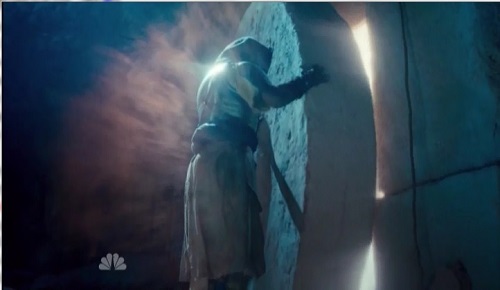
“There was a violent earthquake, for an angel of the Lord came down from heaven and,
going to the tomb, rolled back the stone and sat on it.” (Matt 28.2)
(mobile/tablet format) (wmv [IE])
This one event is a powerful testimony confirming:
1. The existence of God and angels
2. The resurrection of Jesus
3. The veracity of the claims of Jesus
Considering the inability of the Jewish elders (or skeptics of today) to provide a feasible explanation to the empty tomb, coupled with the resurrection appearances and the silent but powerful testimony of the massive stone; one quickly concludes this triad of evidence forms an air-tight case. The evidence all points to the same inescapable fact: Jesus Christ rose bodily from the dead.
Thus the greeting heard every Easter, likely used by Christians at the first commemoration of the resurrection is still true today:
The Lord is risen!
He is risen indeed!
Duane Caldwell | posted 5/12/2015 | printer friendly version
Follow @duanecaldwell
Related Article:
AD Apologetics – Part 1: Jesus’ death and the Empty Tomb
Notes
1. Rudolf Bultmann, Kergma and Myth: A Theological Debate, Edited by Has Werner Bartach, translated by Reginald H. Fuller (London: Billing and Sons, 1954) pp.38-39
Referenced from Normal L. Geisler, The Battle For the Resurrection Nashville, TN: Thomas Nelson, Inc., 1989) p. 71
back
2. The Journal of the American Medical Association (JAMA) concluded in 1986 concerning the death of Jesus, that:
“Clearly the weight of historical and medical evidence indicates Jesus was dead before the wound to his side was inflicted and supports the traditional view that the spear, thrust between his right ribs, probably perforated not only the right lung but also the pericardium and heart and thereby ensured his death.”
Referenced from Normal L. Geisler, “The Battle For the Resurrection” Nashville, TN: Thomas Nelson, Inc., 1989) p. 76-77
Note: Geisler Lists the Journal as the Journal of the American Medical Society, but the correct name is above – ending with Association, not Society; the article was published by the American Medical Association in its journal which goes by the name of JAMA (Journal of the American Medical Association)
The specific article is: “On the Physical Death of Jesus Christ” by William D. Edwards, MD; Wesley J. Gabel, MDiv; Floyd E. Hosmer, MS, AMI, 3/21/1986
Abastract: http://jamanetwork.com/journals/jama/article-abstract/403315
back
3. Scriptures that predict the resurrection of the messiah:
10 Yet it was the Lord’s will to crush him and cause him to suffer, and though the LORD makes his life a guilt offering, he will see his offspring and prolong his days, and the will of the LORD will prosper in his hand.
11 After the suffering of his soul, he will see the light of life and be satisfied; by his knowledge my righteous servant will justify many, and he will bear their iniquities.
Is 53.10-11
10 because you will not abandon me to the grave, nor will you let your Holy One see decay.
Ps 16.10
4. William Lane Craig, On Guard, Colorado Springs, Co: David C. Cook, 1996, Kindle edition Loc 3818
back
5. Normal L. Geisler, “The Battle For the Resurrection” Nashville, TN: Thomas Nelson, Inc., 1989) p.79
back
6. Frank Morison “Who Moved the Stone? Grand Rapids, MI: Lamplighter Books, Zondervan Publishing House, 1958
back
Images: AD: The Bible Continues

